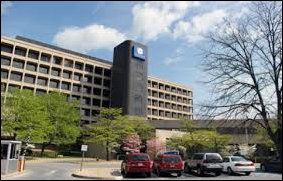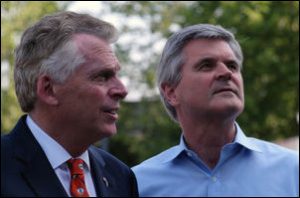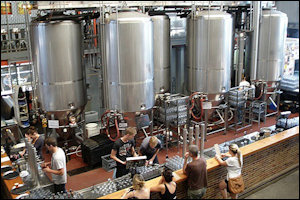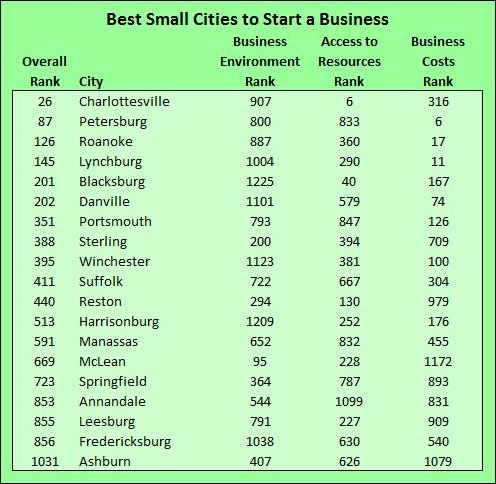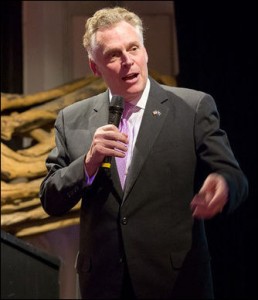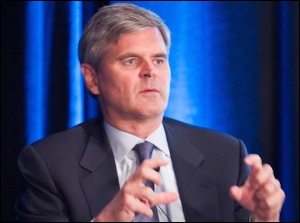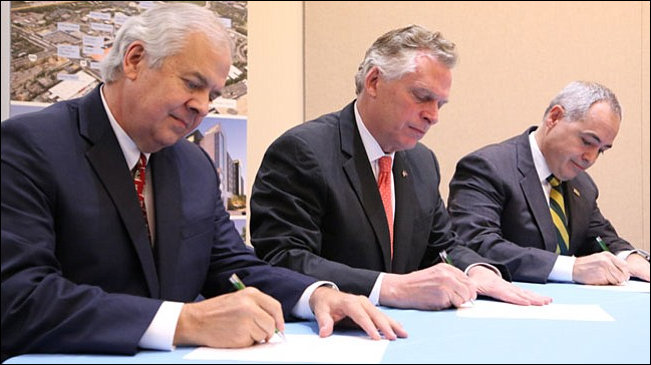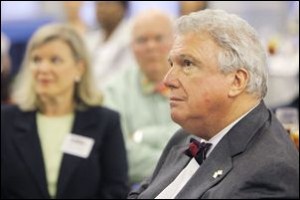
J. Stewart Bryan III. Photo credit: Richmond Times-Dispatch
by James A. Bacon
J. Stewart Bryan III, long-time chairman of Media General Inc., died Saturday at age 77 from complications stemming from a fall at his home. Born and bred as a newspaper man, he presided in recent years over the transformation of Richmond-based Media General from a newspaper-dominated conglomerate into a pure-play corporation owning 71 local television stations across the country.
When I joined Media General in 1986 as part of the start-up team for Virginia Business magazine, the company was highly profitable. Newspapers were fat with display advertising, and Sunday editions were so loaded with classified ads they could double as doorstops. The company owned local television stations as well as the Fairfax County and City of Fredericksburg cable television operations, a New Jersey newsprint recycling company and a slew of smaller enterprises. But senior management at the time was widely regarded as aging, decrepit and lethargic, and the company barely fended off an effort by New York money manager Mario Gabelli to put its slate of nominees on the board of directors.
Taking over as CEO in 1990 Bryan brought new executive talent into the organization and as well as a philosophy of tempered change. A true Richmond blue blood, he epitomized what was best and worst about the city’s aristocracy. He was always the gentleman, unfailingly polite and considerate to those around him. He was unflappable in temperament and loyal to those who had been loyal to him (and to his father, former CEO D. Tennant Bryan). From what I could observe, he was highly ethical in his business and personal conduct. While I felt plenty of pressure from above as publisher of Virginia Business magazine (a tiny cog in the larger machine) to raise profitability, I was never encouraged to take ethical short-cuts of any kind.
The flip side of Bryan’s gentility was excessive caution in steering the company into the future. Media General was slow and halting in responding to the Internet challenge — although, in retrospect, it’s not clear that any other newspaper has performed much better. At a measured pace, Bryan did some smart things. He sold the cable properties to Cox Communications at a huge premium. He sold the cyclical, capital-intensive newsprint recycling business. He sloughed off smaller non-media properties. And by the early 2000s, he had presided over the refocusing of Media General into a media company with newspapers, television and Internet. The vision, as best exemplified in the company’s Tampa operation, was to fuse the unique strengths of television, newspaper and the Internet into an integrated media platform.
To this day, I think it was a pretty good vision. If the world had moved at a slower pace (and if federal regulations hadn’t made it nearly impossible to own television and newspapers in the same media market), it might have worked. But no one anticipated the speed with which the Internet would disrupt the newspaper industry. Within a few short years, classified advertising — jobs, cars, real estate, personals — moved online, gutting newspaper revenues. The volume of display ads shrunk, too, and newspapers lost pricing power as readers of the print content and the display ads embedded in them migrated to Internet content and banner ads. While newspapers could boast of more readers than ever by combining print and online numbers, advertising yielded far less revenue per reader. As sales tanked, newspapers survived by cutting costs, including newsrooms, which diminished the value of their content in the eyes of readers. It was a vicious cycle that no one, not even the Jeff Bezos-owned Washington Post, has figured out how to reverse.
I saw most of this coming and in my last couple of years at Virginia Business, I desperately tried to transplant our still-strong business-to-business brand onto the Internet by means of hybrid print-Internet products and even some unique Internet-platform products. I felt confounded by an unwillingness of Media General to fund any initiatives — we had to boot-strap everything — and my inability to circumvent the incompetent leadership of the company’s Internet team. In my final gambit, I presented a proposal asking Media General to invest in an enterprise I called “Datamancer,” which would have leveraged the Virginia Business brand to create a cluster of business-intelligence products capable of generating a subscription-driven revenue stream. There was zero interest in the idea — perhaps less than zero interest. The response was more like, ew, get this proposal off my desk! I departed Media General soon thereafter, in 2002.
I cannot say my idea would have succeeded, but that’s almost irrelevant. The larger point was the lack of interest in even exploring it. My penchant for blurting out awkward truths in management meetings probably did not help me. But Media General’s corporate culture was antithetical to outside-the-box thinking. The company pursued a strategy within its field of competency of acquiring other media properties, consolidating operations, sharing costs and cutting overhead. Needless to say, Media General did not succeed in cost-cutting its way to growth.
Indeed, the company nearly met an early demise when it borrowed heavily to purchase a chain of television stations, roughly doubling its television portfolio. Bryan was no longer CEO then, but he allowed the transaction to move forward. When the 2008 recession hit soon thereafter, Media General was way over-extended financially. Amidst speculation that the company might default on its bonds, shares of its stock fell as low as $1 per share. The company survived by restructuring its debt in a last-minute deal and by unloading its newspapers. Since then, the company has rebounded smartly, with the promise of an extra boost from a federal ruling that will allow television stations to auction some of their broadcast spectrum.
I can’t imagine that Bryan, who had long before relinquished his role as CEO, had the same attachment to Media General in his final days that he did back when served as publisher of the Richmond Times-Dispatch. But it must have been some consolation to him that the fortunes of the company had rebounded to $16 a share.
Media General is in the midst of a bidding war right now, and there is a chance that it could be purchased by Des Moines-based Meredith Broadcasting Group at a modest premium. With Bryan gone, there is little to tie the corporate headquarters to Richmond. If Meredith takes over and consolidates operations in Iowa, Richmonders may have yet another reason to mourn Bryan’s passing.
There is a larger lesson here for those who obsess about the inequality of wealth and the rise of a permanent aristocracy. Once upon a time, Stewart Bryan ranked among Virginia’s wealthiest citizens. With money, lineage and social standing, he was a central figure in Richmond’s old elite. Disrupted by the Internet, the source of that wealth has shriveled. The old blue bloods hold no sway in Richmond any longer. Bryan’s passing marks the fading of a way of life. As long as America’s economy remains free, vibrant and dynamic, new generations of wealth will always supplant the old.
